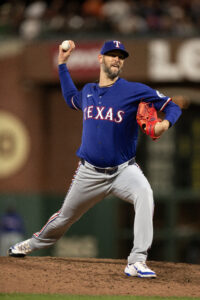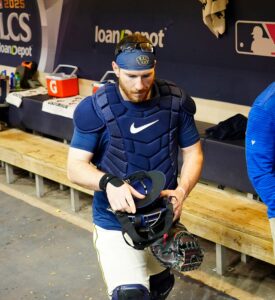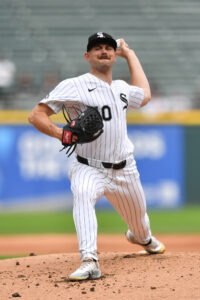T.R. Sullivan was a legend on the Rangers beat. He retired in December 2020 after 32 years writing for the Denison Herald, Fort Worth Star-Telegram and MLB.com. T.R. is also a friend to MLBTR, and recently he kindly offered up a retrospective on the Frank Robinson for Milt Pappas trade. “I just felt like writing it,” T.R. explained. We’re proud to publish it!
Of all the thousands of baseball trades made down through the decades, only one was brought up by Annie Savoy in her opening soliloquy for the movie Bull Durham.
“But bad trades are part of baseball – now who can forget Frank Robinson for Milt Pappas, for God’s sake?” Savoy said in discussing the off-the-field attributes of various Minor League players.
Such titillating comparisons aside, it is now 60 years since the Cincinnati Reds traded Robinson to the Orioles not only for Pappas but also reliever Jack Baldschun and young outfielder Dick Simpson.
It is one of the most significant and possibly lopsided trades in baseball history. Robinson, now in the Hall of Fame, was one of the best players in the National League, right up there with Willie Mays, Hank Aaron and Roberto Clemente.
When he went to Baltimore, he turned the Orioles from a contender into a dynasty by leading them to four pennants and two World Series titles in a six-year span. His 1966 season was the best year of his career as he won the Triple Crown by hitting .316 with 49 home runs and 122 RBI. Not only was he American League MVP but World Series MVP with two home runs in the Orioles four-game sweep of the Dodgers.
So, what were the Reds thinking in making such a foolish trade? Were they that stupid? Was it really because Robinson was going to be an “old 30” as Reds general manager Bill DeWitt suggested after the trade.
The Reds couldn’t have been too stupid. Earlier that year, in the first ever June amateur draft, they selected high school catcher Johnny Bench in the second round. They took Bernie Carbo in the first round and Hal McRae in the sixth round. The 1965 Reds already had two other future Hall of Famers in Pete Rose and Tony Perez in place.
It came down to one thing for a team that had finished 89-73 in 1965 and eight games out of first place.
“The name of the game is pitching,” DeWitt said in announcing the trade. “The lack of it, especially in the bullpen, beat us last season.”
Pitching was the name of the game for the Los Angeles Dodgers in 1965. They won the World Series with a rotation led by Sandy Koufax, Don Drysdale, Claude Osteen and Johnny Podres, plus relievers Ron Perranoski and Bob Miller.
The Dodgers had the best pitching across the board with a team ERA of 2.81 and WHIP of 1.117. The Reds had the second highest ERA (3.88) and WHIP (1.333) in the National League.
That’s where you start when you sit back on the 60th anniversary of one of baseball’s most famous trades and try to figure out how it went down.
Offensively, the Reds led the N.L. by scoring 5.09 runs per game. The Braves were second at 4.37. Robinson, who hit .296 with 33 home runs and 113 RBI, was just part of the Reds offensive arsenal.
Rose had a breakout season as the Reds 24-year-old second baseman, hitting .312 with 117 runs scored, 35 doubles, 11 triples and 11 home runs. He batted second most of the year behind outfielder Tommy Harper, who hit .257/.340/.393 while stealing 35 bases and leading the league with 126 runs scored.
Vada Pinson batted third, the center fielder who played 18 years in the big leagues and put up near-Hall of Fame career numbers. He hit .305/.352/.484 with 22 home runs and 94 RBI in 1965. He was also 27 at the time of the trade and perceived to be at the top of his game.
The big bat to replace Robinson in the middle of the lineup was third baseman Deron Johnson, a former failed Yankees and Athletics prospect. The Reds had bought him from Kansas City in April of 1963, and he spent that entire season at Triple A San Diego. He joined the Reds lineup in 1964 and had a career year in ’65, hitting .287/.340/.515 with 32 home runs and a league-leading 130 RBI.
In 1966, the Reds moved Johnson to left to join Pinson and Harper in the outfield. Tommy Helms took over at third base and was Rookie of the Year. Perez platooned with veteran Gordy Coleman at first.
Three-time All-Star catcher Johnny Edwards (two Gold Gloves) and shortstop Leo Cardenas, a five-time All-Star who had won a Gold Glove in ’65, also helped make it a formidable lineup. Behind all of this were two excellent hitting prospects in Lee May and Art Shamsky, and a highly regarded infielder in Chico Ruiz.
When you look at all that, the Reds had reason to believe they would be fine offensively without Robinson in their lineup. They wanted arms. They had two of them.
Jim Maloney and Sammy Ellis were top of the rotation starters. At least they presented that perception and with Maloney, there was no doubt. He was 25 years old and was 20-9 with a 2.54 ERA and 1.17 WHIP in 1965. He struck out 244 in 255 1/3 innings with a fastball in the upper 90’s and a good curve.
On June 14, he struck out 18 and walked one in a 1-0 loss to the Mets in 11 innings. The Mets didn’t get a hit until the 11th. On Aug 19, he pitched a 10-inning no-hitter with a 1-0 victory over the Cubs. He walked 10 and struck out 12.
Ellis wasn’t in Maloney’s class. He was a 22-game winner in 1965 but with a 3.79 ERA. He gave up 111 earned runs, the most in the league and his ERA-plus was 99, slightly below average. That he benefitted from offensive support is obvious. But in 1965, if you won 22 games, you were considered an elite pitcher.
The Reds next two starters had once been elite pitchers until falling off in 1965. Left-hander Jim O’Toole had won 81 games from 1960-64, including 19 in 1961 when the Reds won the pennant. Joey Jay won 21 that season and 21 in ’62. But in 1965, O’Toole was 3-10 with a 5.92 ERA while Jay was 9-8 with a 4.22 ERA. Fifth starter Joh Tsitouris was 9-8 with a 4.95 ERA.
The Reds figured either O’Toole or Jay could bounce back in ’66. They still wanted one more prime starter in the era of four-man rotations.
Trading a hitter for a pitcher worked for the Dodgers the previous winter when a seven-player deal with the Senators sent power-hitting outfielder Frank Howard to Washington for left-hander Claude Osteen. That gave the Dodgers a reliable third starter and Osteen won 15 games. He also threw a five-hit shutout in Game 3 of the World Series after the Dodgers had lost the first two games in Minnesota.
“I’d still have say the Reds had the strongest starting lineup in our league last season,” Giants manager Herman Franks told the Cincinnati Enquirer. “Outside of pitching, the Dodgers didn’t compare with the Reds position for position.”
Pappas had been a solid starter for the Orioles for eight years. He was 18 when he broke into the Orioles rotation in 1958 and had averaged 13.8 wins over seven seasons with a 3.25 ERA and a 1.21 WHIP. He was good for 200 innings a year but hardly overpowering. He averaged 5.2 strikeouts and 2.9 walks per nine innings.
The Orioles were willing to do the deal because they were loaded with young pitchers, many like Dave McNally, Wally Bunker, Jim Palmer, Dave Leonhard, Eddie Watt and Tom Phoebus who would become part of the budding dynasty in Baltimore.
Obviously, Pappas for Robinson was not a fair trade. But Annie Savoy forgot to mention the Reds also got reliever Jack Baldschun and outfielder Dick Simpson.
Point of interest: The Orioles had just acquired Baldschun and Simpson in separate trades earlier that month from the Phillies and Angels. Orioles general manager Harry Dalton later insisted those deals were not made so the two players could be included in a deal for Robinson.
The Reds had every reason to believe Baldschun, 29, would be a big help to their bullpen. He had spent five seasons in the Phillies bullpen, averaging 66 appearances and 108 innings per season. His ERA in that stretch was 3.18 with a 1.34 WHIP. A reliever of that quality was a valuable commodity. The trade was intended to reinforce both the Reds rotation and the bullpen.
Simpson, 22, was no throw-in. He spent 1965 at Triple A Seattle in the Angels organization and hit .301/380/.523 with 24 home runs and 29 stolen bases. Speed and power in a guy just 22 years old was not a bad addition to the trade. That he struck out 148 times might have been a red flag, but he was No. 3 in the deal. DeWitt compared him to Tommy Harper.
So, there you have it. For Frank Robinson, the Reds picked up a No. 3 starter behind Maloney and Ellis, proven relief help and an outfield prospect.
So what did everybody say to their local reporters.
“I am thrilled with the deal,” Dalton said in the Baltimore Sun. “Because it gives us the power hitter we have sought for so long.”
“We hated to give up Robby,” DeWitt said in the Cincinnati Post. “But you’ve got to give up something to get something good and we would rather sacrifice an older player than a younger player. A top-flight starter and a top-flight reliever was just too attractive a package to turn down.”
The trade turned out to be a disaster for the Reds. They went from winning 89 games in 1965 to 76-84 in ’66. Manager Don Heffner was fired after 83 games.
So what went wrong?
Pappas was not a top-of-the-rotation starter. He had a nice career, winning 209 games, but No. 2 or 3 at best. In 1966, he was barely that, going 12-11 with a 4.29 ERA in 209 innings. He won 16 in 1967, then was traded to the Braves in 1968. He was traded to the Cubs in 1970 where manager Leo Durocher founded him to be a “clubhouse lawyer” and disruptive personality.
Baldschun? The Reds discovered what everybody should understand in baseball. Relievers are a risk because of their heavy workloads and erratic usage over multiple seasons. Baldschun went 1-5 with a 5.49 ERA, either because of a tired arm or hitters were no longer fooled by his screwball. But he was done as an effective reliever.
Simpson was no Frank Robinson or Tommy Harper. He was a classic “4A player” who could run but couldn’t hit at the big-league level. His less than memorable seven-year career covered six organizations and ended with a .207 batting average.
The Reds offense suffered without Robinson, scoring 133 less runs. Their pitching wasn’t any better as the team ERA went up from 3.88 to 4.08. Ellis was 12-19 with a 5.29 ERA, a bigger disappointment than Pappas or even Baldschun.
But again, the Reds weren’t dumb. They were just a few years away from the greatest era in franchise history when the Big Red Machine won four pennants and two World Series from 1970-76. Over a 21-year period from 1961-81, the Reds had 19 winning seasons.
It just comes down to what Annie Savoy said. Bad trades are a part of baseball.
]]>


